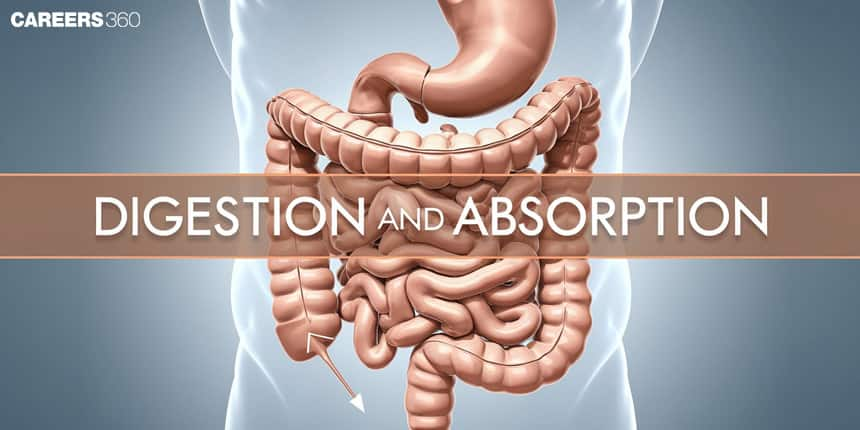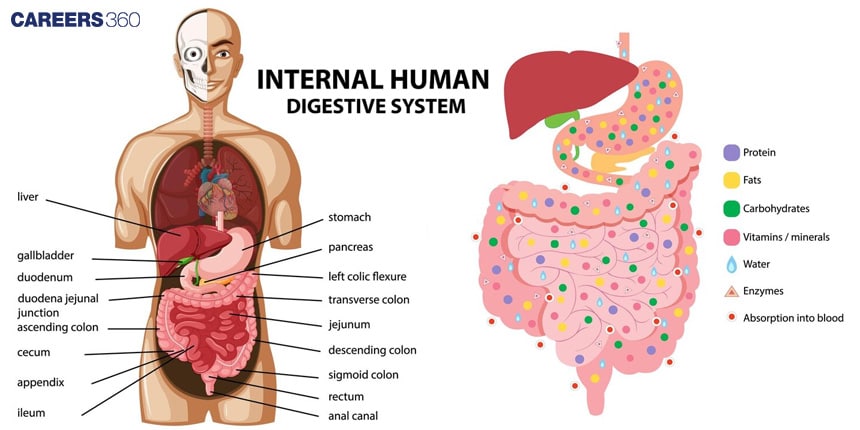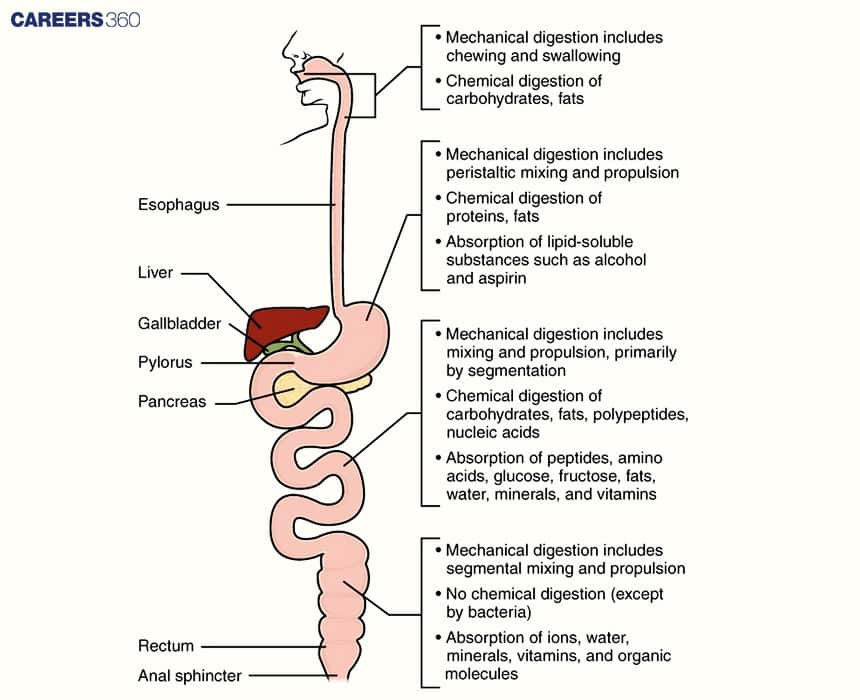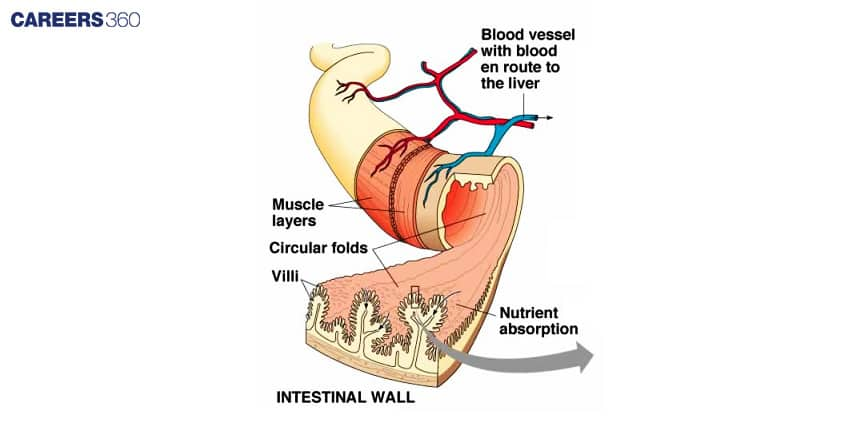Digestion And Absorption: Overview, Topics, Books, Tips, Diagrams
Digestion and Absorption is the process by which food is broken down into smaller units, which are simpler forms of nutrients that can be absorbed into the body. The study of this topic includes the structure of the digestive system, digestive enzymes, glands, and the mechanisms of nutrient absorption in various organisms. It provides a foundational base for advanced studies in medicine, biochemistry, and biology. The digestion and Absorption chapter carries a weightage of 4-5% of the total marks in NEET and 2-3% of the weightage of other entrance exams like Paramedical. Explore more about the chapter overview, important topics, process and mechanism, books, tips, and Importnt diagrams. know what is digestion and what is absorption.
Latest: NEET 2024 Paper Analysis and Answer Key
Don't Miss: Most scoring concepts for NEET | NEET papers with solutions
New: NEET Syllabus 2025 for Physics, Chemistry, Biology
NEET Important PYQ & Solutions: Physics | Chemistry | Biology | NEET PYQ's (2015-24)
- Important Topics of Digestion and Absorption
- Overview of the Chapter
- What Is The Human Digestive System?
- Major Organs in Digestion
- Stages Of Digestion
- Mechanism of Digestion
- Role of each Organ in Digestion and Absorption
- Biochemical Processes Of Digestion
- Role of Enzymes and Digestive Juices
- Tips, Tricks, and Strategies for Digestion and Absorption
- Types of Questions and Weightage of Digestion and Absorption in Exams
- Prescribed Books for Digestion and Absorption
- Recommended Video for Digestion and Absorption

Important Topics of Digestion and Absorption
- Human Digestive System
- Alimentary Canal
- Digestive Glands
- Absorption of Food
- Disorder of the Digestive System
Overview of the Chapter
Digestion starts in the mouth the moment food enters it. Teeth crush food, and saliva initiates the chemical digestion of carbohydrates. Peristalsis continues to break down food as it moves through various sections of the alimentary canal: first the oesophagus, second, the stomach, and third, the small and large intestines, each region mixing that food with various enzymes and acids. It is a complex journey that ends in absorption, with which the nutrients will be absorbed into the blood to be utilized by cells to sustain all the vital functions of life.
What Is The Human Digestive System?
Imagine that you're having a great dinner, enjoying your food bits. But have you ever thought about exactly what happened to your food after it left your plate and passed on to your body? How food is digested within the human system is rather a dire and interesting journey for survival. Each piece of your food intake undergoes stringent changes, breaking it down into nutrients that help energize your body with all the vital functions.
Attention to the human body's digestive system enables one to make much better food choices and fosters appreciation for the inner complexity of what goes on within us. In this paper, we will look into the structure, and function of the digestive system, look at the steps of digestion, and discuss practical applications and relevance in our daily lives.
Diagram: Human Digestive System

Mechanical digestion is the process of the physical breakdown of large portions of foods into smaller pieces.
It makes it easier for our digestive system enzymes to break it down.
Chemical digestion is used in chymes to break down food particles in the small molecules that our body can absorb.
Water from undigested foods is absorbed in the large intestine.
The undigested food goes under process and is removed via large intestines.
In the large intestine goblet cells help absorb water from the dietary residues.
Also Read
Major Organs in Digestion
Mouth: The mouth is the anterior opening of the digestive system. It receives food and breaks it down mechanically and chemically into more manageable substances.
Esophagus: This is a muscular tube that conveys food from the mouth down to the stomach.
Stomach: A sac-like organ that churns up food and mixes it with digestive juices.
Small Intestine: This is a scrollbar-like tube and is the site for most digestion and absorption of nutrients.
Large Intestine: This absorbs water and produces waste products in the form of faeces.
Rectum and Anus: These store and expel faeces.
Accessory Organs
Liver: This manufactures bile for fat digestion.
Pancreas: Secretes digestive enzymes and bicarbonate.
Gallbladder: It stores and concentrates the bile.
These are the major constituents which become the base of the digestive system to hold up the complicated process of digestion.
Digestion is a step-by-step process that finally alters food into absorbable nutrients and waste products.
Stages Of Digestion
The stages of digestion are:
Ingestion
The digestion process starts in the mouth, where food is chewed and mixed with saliva to form a bolus.
Mixing And Movement
Muscle contractions in the oesophagus pass the bolus into the stomach, a wave of contractions that propel food down the digestive tract in wave-like peristalsis motions.
Additional mixing with digestive juices in the stomach breaks down the food into a semi-fluid substance called chyme.
Secretion
Digestive enzymes, bile, and other juices are secreted by the stomach, pancreas, liver, and small intestine which help in digestion.
Digestion
Enzymes break down carbohydrates, proteins, and fats in the small intestine into smaller molecules.
Absorption
Nutrients are absorbed through the walls of the small intestine into the bloodstream.
Excretion
Absorption of water and the formation of waste products in the large intestine, followed by proper excretion of waste through the rectum and anus.
These are the steps of digestion, each of which stands to be highly important in making food into energy and valuable nutrients.
In this regard, the digestive system has become very basic not just for nutrition but also with strong health and disease links. Knowing digestion thereby makes it possible to maintain better health and prevent diseases.
Mechanism of Digestion
Food absorption generally refers to the act or process of absorbing or assimilating. Absorption in biology refers to the process of absorbing or assimilating substances into the cell or across tissues and organs. absorption of food takes place in the small intestine. The small intestine is responsible for the absorption of minerals and vitamins from food.
As the meal enters the mouth, it undergoes mechanical digestion via means of mastication (chewing) and will additionally become whilst it's far in contact with saliva. Saliva incorporates salivary amylase which begins off evolving the digestion of starch inside the meals.
Some important events of Digestion are discussed below:
Process | Details |
Mouth (Mechanical) |
|
Bolus Formation |
|
Esophagus (Peristalsis) |
|
Stomach (Chemical) |
|
Chyme Formation |
|
Duodenum (Enzyme and Bile) |
|
Small Intestine (Absorption) |
|
Large Intestine (Water) |
|
Colon (Vitamins) |
|
Waste Material |
|
NCERT Notes Subject Wise Link:
Role of each Organ in Digestion and Absorption
The Mouth: Digestion in the mouth starts right from the act of chewing and partial digestion by food mixed with saliva to break the carbohydrates down with salivary amylase into simpler subunits.
Esophagus: The rhythmic muscle contraction, known as peristalsis, moves the bolus to the stomach.
Stomach: The cellular lining secretes gastric juices for hydrolysis of proteins to chyme.
Small Intestine: Principal area of nutrient absorption aided by villi and microvilli. They are finger-like outgrowths still increasing the absorptive area.
Large Intestine: This is where the absorption of water and electrolytes occurs. It is also the site where the faeces are collected and expelled.
Diagram: Description Of Peristalsis
Peristalsis is the involuntary contraction of muscular nature, it allows a wave to help move food down the tract through which digestion and absorption take place.
Given below is the diagram of the peristalsis movement in the body.

Biochemical Processes Of Digestion
Digestion is the process by which macromolecules get broken down into smaller molecules that will be free for absorption and utilization within the body.
Digestion of Carbohydrates
Digestion of carbohydrates is initiated inside the mouth, facilitated via means of salivary amylase. The majority of carbohydrate digestion takes place inside the small gut. The important enzyme is pancreatic amylase, which yields disaccharides from starch via means of digesting the alpha 1-four glycosidic bonds.
The disaccharides produced (maltose, maltotriose, and α-dextrins) are all transformed to glucose via means of brush border enzymes.
Disaccharides going on clearly in meals do now no longer require amylase to interrupt them down. Brush border enzymes (lactase, sucrase, trehalase) hydrolyze those compounds into molecules of glucose, galactose, and fructose.
Absorption of Glucose
Glucose and galactose are absorbed throughout the apical membrane via means of secondary energetic transport (alongside Na+) via the Sodium-Glucose cotransporter (SGLT1).
Both glucose and galactose go out of the cellular through GLUT2 receptors throughout the basolateral membrane into the blood. Fructose enters the cellular via means of facilitated diffusion through GLUT5 and is transported into the blood through GLUT2 receptors.
Protein Digestion and Absorption
Digestion of protein and fats takes place throughout the digestion at different sites. Some of the major sites are discussed below:
Digestion location | Details |
Protein Digestion (Stomach) |
|
Protein Digestion (Small Intestine) |
|
Protein Absorption |
|
Fat Digestion (Small Intestine) |
|
Fat Absorption |
|
NCERT Exemplar Solutions Subject-wise link:
Role of Enzymes and Digestive Juices
Starches: Exstarches. Ptyalin in the saliva and amylopsin secreted pancreatic reaction small intestines degrade complicated starches into monosaccharides, where, monosaccharides are monomeric small sugars.
Proteins: In the stomach, the principal work of protein digestion is done by the gastric juice, namely the pepsin; then, in the small intestine, the pancreatic juice – trypsin and chymotrypsin continue protein digestion.
Fats: Fats emulsified from the bile salts are further broken down with pancreatic lipase fats into fatty acids and glycerol, the resultant products that can be absorbed.
Villi and Microvilli
The increased surface area of the small intestine increases the absorption of nutrients Glucose, Amino acids, and fatty acids into the blood and lymph.
Diagram: Intestinal Wall

Transport of Nutrients
Nutrients absorbed into villi are transported via capillaries (for water-soluble nutrients) or lacteals (for fats) to various tissues for energy and cellular functions.
Importance of a Balanced Diet
It is a balanced nutrient diet that, in itself, will ensure proper digestion and excellent absorption levels of the nutrients that the body requires for the functions and energy metabolism processes.
Ncert Books Link:
Practical Implications and Applications
These are the practical implications and applications of the digestion process:
Dietary Choices
Knowing digestion helps in choosing a diet. For example, food that is high in fibre would promote the movement of the bowels and avoid constipation.
Prevention Of Disease
Healthy digestion is known to relate to a variety of diseases, from acid reflux to IBS and Crohn's. A good diet coupled with the concept of digestion can help in their management and even in preventing them.
Medical Applications
Medical fields: In-depth knowledge of the digestion process will help to formulate treatment options against digestive disorders. For instance, supplements comprising enzymes can help individuals with insufficient functioning of the pancreas.
Nutritional Science
Nutritionists apply their digestive-system-related expertise in designing diets that are balanced and will yield maximum absorption for optimum health benefits.
Everyday Relevance
Knowing how our digestive system works is bound to instigate responsible eating, hence attaining better health and well-being in general.
Tips, Tricks, and Strategies for Digestion and Absorption
It's hard to remember everything in a single go. We made the entire problem easy. Some of the tricks regarding Digestion and Absorption are given below which you can use to memorize the important points.
Digestive Enzymes
"SAp Lipase Peps Trys"
S: Salivary Amylase (breaks down starch in the mouth)
L: Lipase (breaks down fats)
P: Pepsin (breaks down proteins in the stomach)
T: Trypsin (breaks down proteins in the small intestine)
Major Digestive Organs
"MEPS: Mouth, Esophagus, Pancreas, Small Intestine"
M: Mouth (chewing and starch digestion)
E: Esophagus (peristalsis moves food to the stomach)
P: Pancreas (releases digestive enzymes)
S: Small Intestine (main site of nutrient absorption)
Functions of Bile
"BED: Bile Emulsifies Digest"
B: Bile emulsifies fats
E: Emulsification breaks down large fat globules
D: Aids Digestion of lipids
Nutrient Absorption in the Small Intestine
"CAM Fat Solutes"
C: Carbohydrates absorbed as glucose
A: Amino acids absorbed through active transport
M: Monoglycerides absorbed into the lymphatic system
F: Fatty acids absorbed via simple diffusion
S: Solutes (water, minerals) absorbed in the large intestine
Layers of Digestive Tract
"MSMS: Mucosa, Submucosa, Muscularis, Serosa"
M: Mucosa (innermost layer for absorption)
S: Submucosa (connective tissue with blood vessels)
M: Muscularis (smooth muscle for peristalsis)
S: Serosa (outer protective layer)
Hormones in Digestion
"GSS: Gastrin, Secretin, CCK"
G: Gastrin (stimulates HCl secretion in the stomach)
S: Secretin (stimulates pancreatic juice release)
S: CCK (stimulates bile release from the gallbladder)
NCERT Solutions Subject-wise link:
Types of Questions and Weightage of Digestion and Absorption in Exams
The table below indicates the weightage and types of questions asked on Digestion and Absorption in exams:
| Exam Type | Types of Questions | Weightage |
|---|---|---|
| CBSE | Short answer questions on digestive enzymes, digestion processes, absorption mechanisms, and structure of the digestive system. | 4-5% |
| MCQs cover digestive glands, hormone regulation, enzyme functions, disorders (like ulcers), and nutrient absorption. | 3-4% | |
| AIIMS | Assertion and reason questions on enzyme action, absorption of nutrients in different parts of the digestive tract, and related disorders. | 2-4% |
| Nursing Entrance Exams | Scenario-based questions on digestive disorders, nutrient deficiency, and roles of vitamins and enzymes in healthcare. | 2-3% |
| Paramedical Exams | True/False and MCQs on digestion, nutrient absorption, and the role of the digestive system in overall health. | 1-3% |
Prescribed Books for Digestion and Absorption
NCERT Biology textbook class 11 forms the base for learning the digesting and absorption process. Further extended understanding of the concept can be done through "Trueman's Elementary Biology, Volume 1", which provides all essential explanations with practice questions. Another helpful book is "Pradeep's Biology" which provides proper explanations with solved examples. Other great videos, articles, and practice mock tests are available on the Careers360 website for this topic. Since consistent practice with these resources will prepare you for both board exams and NEET, this combination is excellent.
Also Read:
Recommended Video for Digestion and Absorption
Frequently Asked Questions (FAQs)
Protein digestion takes place inside the belly and duodenum. Pepsin, which is secreted via means of the belly, and trypsin and chymotrypsin secreted via means of the pancreas, spoil down meal proteins into polypeptides.
The digestive enzymes are normally secreted as their inactive precursors referred to as zymogens. For example, trypsin is secreted via way of means of the pancreas inside the shape of trypsinogen, which is activated inside the duodenum via way of means of enterokinase to shape trypsin. Proteins are then broken up into smaller polypeptides by trypsin.
Bile juice is essential for digestion. It is a digestive juice that is produced via means of the liver. Even though it has no digestive enzymes, it has an important position to play in fat digestion. Bilirubin and biliverdin are the 2 bile salts that can be found in bile juice, which disintegrates big globules into smaller globules such that the pancreatic enzymes can act on them easily. This phenomenon is called the emulsification of fats. The bile juice is likewise recognized to make the medium alkaline and is concerned with the activation of lipase.
The partitions of the belly secrete hydrochloric acid, which dissolves fragments of meals and builds an acidic environment. This medium enables the conversion of pepsinogen into pepsin. Pepsin performs an important position in protein digestion.
Pepsin might be inactivated if HCl has now no longer been secreted withinside the belly which might have an impact on the digestion of proteins. To digest proteins, a pH balance of eight is necessary. HCl provides this balance.
Every tooth in humans is embedded in a socket of the jaw bone. This attachment of enamel is called codont. Most mammals and humans produce units of enamel during their lifetime. First, as a fix of milk enamel or deciduous enamel which can be transient, and 2nd a fix of grownup enamel which can be everlasting. The transient milk enamel is changed via means of everlasting grownup enamel. This dentition is called diphyodont.
Digestion may be defined because of the procedure via means of which the meals we devour pass via our bodies and is directed toward the functions of presenting the frame with electricity or constructing new mobile additives and tissues, consisting of muscle or fats. absorption of digested food takes place in the small intestine. The digested food is absorbed by the villi in the small intestine. The components of meals that the frame can not use and additionally different wastes from the frame are removed withinside the shape of excrement.
Thecodont: In humans, every tooth is embedded in a socket of the jaw bone. Such enamel is defined as the thecodont.
Diphyodont: The majority of mammals such as humans shape units of enamel at some stage in their life, a fix of transient milk or deciduous enamel changed via means of a fix of everlasting or grownup enamel. This form of dentition is referred to as diphyodont.
The extraction of nutrients from the food we take is known as the Absorption of food.
Digestion: The breakdown of the food into absorbable molecules.
Absorption: The passage of these small molecules into the bloodstream or the lymphatic system.
The stomach releases acids and enzymes for the breakdown of food proteins in the stomach cavity. This occurs in the earlier steps of protein digestion.
Villi and microvilli in the small intestine increase the surface area for absorption of nutrients to enter into the blood.
A balanced diet contributes to digestion and absorption in the human body, enabling him to stay healthy and free from diseases.
Symptoms of indigestion are bloating, gas, constipation, and/or diarrhoea, or any other symptom that leads to the disease of the digestive system that maybe should be treated.
Also Read
30 Nov'24 03:25 PM
26 Nov'24 05:38 PM
25 Nov'24 06:43 PM
25 Nov'24 05:45 PM
25 Nov'24 04:48 PM
25 Nov'24 03:52 PM
23 Nov'24 04:30 PM
23 Nov'24 10:03 AM